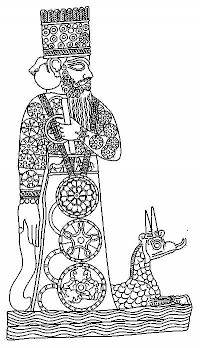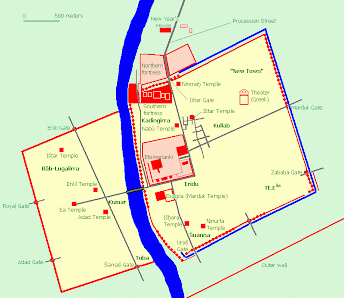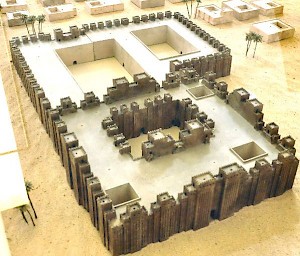Babylon, Esagila
Q928707Esagila or Esagil (Sumerian, "The house that rises its head"): temple of Marduk, center of the Babylonian state cult.

Originally, Marduk was the god of Babylon, but in the eighteenth century BCE, when this city became the capital of Babylonia, he became the supreme god of the Mesopotamian pantheon. As such, he was recognized by the gods of the cities that were subjected by the Babylonian kings.
According to myth, Marduk defended the other gods against the diabolical monster Tiamat. After he had killed her, he brought order to the cosmos, built the Esagila, and created mankind. In the poem Enûma êliš it is stated that all other gods are just manifestations of Marduk.
When the Babylonians celebrated New Year (the Akitu festival), they remembered how Marduk had created order in the universe. The heart of this cosmos was Babylon and the Esagila shrine was, therefore, the center of the universe.

Marduk was, therefore, a very important god. In the first millennium BCE, his name was considered so holy, that it was almost never pronounced; instead, people said and wrote Bêl, 'Lord'.
The Esagila complex was in the center of Babylon. People who entered the Esagila first entered a large court (40x70 meters), then a second court (40 x 25), and finally saw the shrine itself, which consisted of two sacred rooms: an anteroom and the 'holy of holies' where the priests served the cult statue of Marduk and his consort Zarpanitum.

North of the Esagila was the Etemenanki, the 'Foundation of heaven on earth', better known to us as the 'tower of Babel' of Genesis 11. This temple tower (or ziggurat) was 92 meters high and had seven levels.
According to the Greek researcher Herodotus of Halicarnassus, the Persian king Xerxes had a statue removed from the Esagila when he sacked the city.note It is unclear what kind of statue this may have been. Alexander the Great ordered restorations. The Esagila was still functioning in the first century CE.